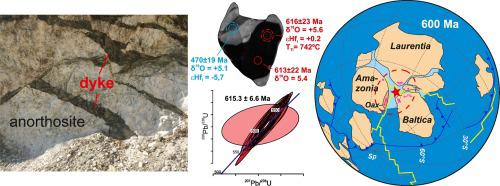当前位置:
X-MOL 学术
›
Gondwana Res.
›
论文详情
Our official English website, www.x-mol.net, welcomes your
feedback! (Note: you will need to create a separate account there.)
Neoproterozoic extension and the Central Iapetus Magmatic Province in southern Mexico – new U-Pb ages, Hf-O isotopes and trace element data of zircon from the Chiapas Massif Complex
Gondwana Research ( IF 7.2 ) Pub Date : 2020-12-01 , DOI: 10.1016/j.gr.2020.06.022 Bodo Weber , Axel K. Schmitt , Alejandro Cisneros de León , Reneé González-Guzmán , Axel Gerdes
Gondwana Research ( IF 7.2 ) Pub Date : 2020-12-01 , DOI: 10.1016/j.gr.2020.06.022 Bodo Weber , Axel K. Schmitt , Alejandro Cisneros de León , Reneé González-Guzmán , Axel Gerdes

|
Abstract Final fragmentation of Rodinia occurred during the Ediacaran Period as Amazonia, Baltica and Laurentia drifted apart to form the Iapetus Ocean. Accompanying rift-related mafic dyke swarms of the Central Iapetus Magmatic Province (CIMP) were emplaced between 0.62 and 0.55 Ga, which are preserved in Laurentia and Baltica, whereas no coeval mafic rocks are known from Amazonia. First evidence for the CIMP extending into Oaxaquia (Rodinia-type basement of Mexico) was reported as tholeiitic dykes that intruded the Novillo gneiss, NE Mexico, at 619 ± 9 Ma. In Chiapas, SE Mexico, amphibolite dykes that are chemically similar to the Novillo dykes intruded anorthosite and gneiss. In this paper, a new dating approach to obtain mafic dyke intrusion ages is presented by targeting contact metamorphic zircon with the U Pb method, employing Secondary Ion Mass Spectrometry. Zircon that crystallized in anorthosite at intrusive contacts to mafic dykes and at temperatures exceeding 700 °C (Ti-in-zircon thermometry) yields ages between 615 ± 7 Ma and 608 ± 12 Ma, reflecting the time of dyke intrusion. Zircon chemical and isotopic (Hf, O) characteristics suggest a diachronous sequence of metamorphic processes involving Zr release from Fe Ti oxides, breakdown and recrystallization of other phases, and fluid-mitigated reactions during Ordovician metamorphism. Zircon δ18O values of granulites from Oaxaquia range from +6.2‰ to +9.8‰, whereas Tonian (~0.92 Ga) metamorphic zircon from SE Chiapas yielded low δ18O values from +2.0‰ to +2.8‰ that are explained by the reactivation of major tectonic boundaries during Tonian gravitational collapse. The observations increase the known extent of the CIMP in Mexico, suggesting that a Neoproterozoic superplume was still active during the Early Ediacaran producing a Large Igneous Province that extended over Amazonia, Baltica and Laurentia. The results further suggest that Oaxaquia at the northern edge of Amazonia formed the conjugate margin of Baltica during rifting.
中文翻译:

墨西哥南部的新元古代延伸和中央 Iapetus 岩浆区——来自恰帕斯地块杂岩的锆石的新 U-Pb 年龄、Hf-O 同位素和微量元素数据
摘要 Rodinia 的最终分裂发生在埃迪卡拉纪时期,因为亚马逊、波罗的海和劳伦西亚漂流形成了土卫六洋。伴随着裂谷相关的中央岩浆省 (CIMP) 的基性岩脉群位于 0.62 和 0.55 Ga 之间,保存在 Laurentia 和波罗的海,而在亚马逊流域中没有发现同期的基性岩。CIMP 延伸到 Oaxaquia(墨西哥的 Rodinia 型基底)的第一个证据被报告为拉斑岩,它在 619 ± 9 Ma 侵入了墨西哥东北部的 Novillo 片麻岩。在墨西哥东南部的恰帕斯州,化学性质与 Novillo 岩脉相似的角闪岩岩脉侵入了斜长岩和片麻岩。在本文中,通过以接触变质锆石为目标,采用 U Pb 法,提出了一种获得基性岩脉侵入年龄的新测年方法,采用二次离子质谱法。在斜长岩中与镁铁质岩脉侵入接触并在超过 700 °C 的温度下结晶的锆石(锆石中钛温度测定法)产生的年龄介于 615 ± 7 Ma 和 608 ± 12 Ma 之间,反映了岩脉侵入的时间。锆石的化学和同位素 (Hf, O) 特征表明了一系列变质过程,包括从 Fe Ti 氧化物中释放 Zr、其他相的分解和重结晶以及奥陶纪变质过程中的流体缓和反应。Oaxaquia 麻粒岩的锆石 δ18O 值范围从 +6.2‰ 到 +9.8‰,而来自 SE Chiapas 的 Tonian (~0.92 Ga) 变质锆石产生了从 +2.0‰ 到 +2.8‰ 的低 δ18O 值,这可以通过主要构造的重新激活来解释Tonian 引力坍缩期间的边界。观测结果增加了墨西哥 CIMP 的已知范围,表明新元古代超羽在埃迪卡拉纪早期仍然活跃,产生了一个延伸到亚马逊河、波罗的海和劳伦西亚的大型火成岩省。结果进一步表明,亚马逊河北部边缘的瓦哈基亚在裂谷期间形成了波罗的海的共轭边缘。
更新日期:2020-12-01
中文翻译:

墨西哥南部的新元古代延伸和中央 Iapetus 岩浆区——来自恰帕斯地块杂岩的锆石的新 U-Pb 年龄、Hf-O 同位素和微量元素数据
摘要 Rodinia 的最终分裂发生在埃迪卡拉纪时期,因为亚马逊、波罗的海和劳伦西亚漂流形成了土卫六洋。伴随着裂谷相关的中央岩浆省 (CIMP) 的基性岩脉群位于 0.62 和 0.55 Ga 之间,保存在 Laurentia 和波罗的海,而在亚马逊流域中没有发现同期的基性岩。CIMP 延伸到 Oaxaquia(墨西哥的 Rodinia 型基底)的第一个证据被报告为拉斑岩,它在 619 ± 9 Ma 侵入了墨西哥东北部的 Novillo 片麻岩。在墨西哥东南部的恰帕斯州,化学性质与 Novillo 岩脉相似的角闪岩岩脉侵入了斜长岩和片麻岩。在本文中,通过以接触变质锆石为目标,采用 U Pb 法,提出了一种获得基性岩脉侵入年龄的新测年方法,采用二次离子质谱法。在斜长岩中与镁铁质岩脉侵入接触并在超过 700 °C 的温度下结晶的锆石(锆石中钛温度测定法)产生的年龄介于 615 ± 7 Ma 和 608 ± 12 Ma 之间,反映了岩脉侵入的时间。锆石的化学和同位素 (Hf, O) 特征表明了一系列变质过程,包括从 Fe Ti 氧化物中释放 Zr、其他相的分解和重结晶以及奥陶纪变质过程中的流体缓和反应。Oaxaquia 麻粒岩的锆石 δ18O 值范围从 +6.2‰ 到 +9.8‰,而来自 SE Chiapas 的 Tonian (~0.92 Ga) 变质锆石产生了从 +2.0‰ 到 +2.8‰ 的低 δ18O 值,这可以通过主要构造的重新激活来解释Tonian 引力坍缩期间的边界。观测结果增加了墨西哥 CIMP 的已知范围,表明新元古代超羽在埃迪卡拉纪早期仍然活跃,产生了一个延伸到亚马逊河、波罗的海和劳伦西亚的大型火成岩省。结果进一步表明,亚马逊河北部边缘的瓦哈基亚在裂谷期间形成了波罗的海的共轭边缘。










































 京公网安备 11010802027423号
京公网安备 11010802027423号